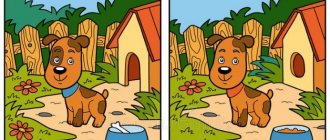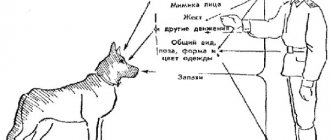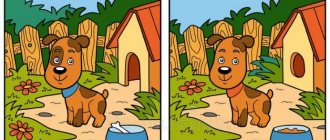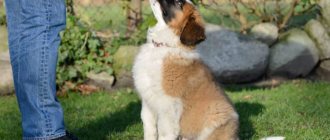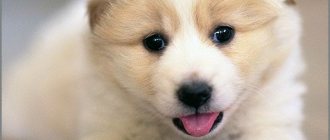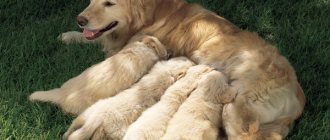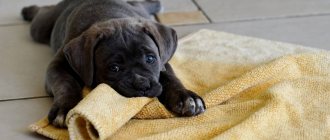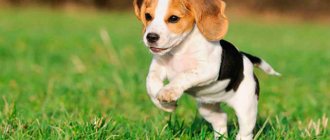On the importance of positive motivation
The educational process should be based mainly on the positive emotions of the pet. Proper motivation will give the dog a desire to learn, and training will be a pleasure for all parties involved. It is important to devote enough time to the puppy so that the established contact becomes the beginning of a close friendship between dog and person.
From the first days it is important to accustom the puppy to its name. You need to pronounce it as often as possible, seeking a response from the pet. When the retriever responds well to its name, you can begin to learn commands. It’s better to start with simple “sit” or “come”, and then master the more complex “can” and “can’t”. During the training process, we must not forget that any training is associated with certain difficulties. Even if not everything works out right away, it is worth remembering that raising a golden retriever requires patience. Excessive punishment will embitter the dog and spoil its attitude towards people.
Walk, be silent, play
The most desirable student for any teacher is the one who loves to learn. If the teacher in you is dying, Golden is the right student for you! Golden Retrievers are extremely trainable for two reasons:
- they are among the top five in the ranking of the smartest dogs in the world (more than 60 breeds participated in testing conducted in 1994!);
- They enjoy following commands and working together with their owner, are interested in praise and love to cooperate.
Learning is not just about intelligence. An animal (or a person) within its species may be an intellectual bordering on genius, but lack communication skills to such an extent that it will not be able to perform simple actions. In Goldens, intelligence is combined with extroversion, curiosity and the ability to quickly process information.
The ability of golden retrievers to learn quickly and effectively is also associated with a training pitfall : even at home, they are extremely demanding in terms of the quality and pace of training. You must exercise your Golden constantly and regularly, satisfying his need for active work - both physical and mental. You can’t give a dog homework: the owner needs to be fully involved in the process and a lot of work.
Getting to know society
One of the main goals of training is to make being around people comfortable for both the dog and society. A feature of the breed is increased sociability and playfulness. Don't let your Golden Retriever rush excitedly at everyone he meets or jump on family members. It is best to do this by avoiding direct punishment, using the commands “fu” and “no”. If the dog is excited and reacts to passers-by and other animals, it is worth distracting it with a game or taking it to a calmer place.
Many people are afraid of large dogs, even if they don't seem aggressive. You should not let your golden retriever run around the street on its own. A dog trained to stay close to the owner's feet in crowded places on a short leash will save him from many unpleasant situations.
Society, in turn, should also be informed of the rules of behavior with a dog. The constant attention of strangers to a cute dog and the desire to pet him can have a bad effect on the pet’s character and make him too trusting. It is advisable that the dog receive affection only in the circle of his owners.
Golden Retriever as a guard
With all their advantages (or rather even because of them), golden retrievers are not at all suitable for protection or guarding : they are never aggressive with people (except for cases where there are serious behavioral disorders).
for any Golden Retriever training course . This is not necessary for service, but to achieve mutual understanding and expand your common capabilities.
- training
- Retriever
If you find an error, please select a piece of text and press Ctrl + Enter.
What tips does a puppy need to give during training?
Training a Golden Retriever is an interesting activity, but it requires complete mutual understanding between the owner and the pet. Training should be clear, accompanied by rewards and tips.
- Important rule: one session - one team. Don't overload your dog with too much information. The ideal workout duration is about 15 minutes. Speak the command clearly and in monosyllables. A simple “lie down” will be learned much faster than the too polysyllabic “you need to lie down here” or “lie down, Bobik!”
- Acceptance of a skill must be developed gradually. In order for the “Sit” command to be well learned, you need to start saying it when the dog is about to sit down or is already sitting. It is important to give the reward treat right away. When the retriever understands the connection between the owner’s command and the required action, you can begin to practice the skill on the street, among many distractions. Training should become a routine part of life. Repeat the learned commands on the street and at home
- Training your Golden Retriever puppy becomes more effective when using sounds or clickers. A specific sound must accompany each correct execution of a command. If there is no suitable noise source, a signal word such as "good" can be used.
Breed varieties
The Golden Retriever is one of the best working dog breeds. The retriever's excellent ability to learn, easy-going character and intelligence make it an indispensable assistant and companion for humans. Golden retrievers are used in rescue services. They make sensitive and devoted guides. A dog's good sense of smell makes it an excellent bloodhound. In addition, the Golden Retriever is an excellent hunting dog.
The breed of these dogs was originally bred as a hunting dog. It is the breed that leaves its mark on the character, behavior and preferences of these dogs. For example, fetching for a Golden is an innate skill and a real passion. He is an excellent swimmer. And his natural obedience makes the training process a pleasure.
There are three types of golden retrievers: American; European; Canadian. This is not to say that they are completely different. Their temperament, intelligence, and life expectancy are completely the same. But there are certain differences that led to the division of the breed into different types. Main differences: Color.
American Golden Retrievers, according to the standard, have a rich, bright golden color with different shades. At the same time, very dark and very light colors are not typical for this type. European retrievers have lighter shades, even pure white; Height. American Golden Retrievers are slightly taller than European Golden Retrievers;
Body structure. The European type is heavier, has a shorter and wider muzzle, as well as shorter legs and a deeper chest. Canadian Retrievers are a cross between the two types above: they are similar in height and build to European Retrievers, but have a lighter color similar to the American type of the breed.
Basic training method
The basis of almost every dog training method is three basic principles:
- Encouragement. You need to praise and encourage your Golden Retriever not only for following commands, but also for any correct action. For example, for friendly behavior with other animals
- Not an encouragement. If a dog does something wrong, it should not receive a reward. If the dog begins to react violently when he sees that the owner is about to take him out for a walk, you should not immediately give him what he wants. It’s worth stopping the training and waiting for the pet to calm down.
- Subsequence. The reaction to the dog’s actions should be the same for all people close to it. If one family member does not allow the dog to sleep on the sofa, and another tries to put him next to him, it is unlikely that correct behavior will ever be learned.
Basic Commands
Among the commands there are those whose initial development is within the power of a small golden retriever who has not yet walked on the street, and those for which training begins later.
There is no need to overtrain the puppy while he is small - it is better to do fewer approaches with better quality than to give ten commands that will be poorly received and executed carelessly. A few walks and you will begin to understand when your baby is losing enthusiasm and his attention is becoming distracted. It is advisable to finish training before this, having prepared in advance for the end of the lesson an exercise that your student can do best, and warmly praising for obedience - this will have a positive effect on mood and motivation (yours too).
"Place!"
The place needs to be equipped before the puppy moves to you. When he begins to get comfortable, take him to the prepared bed, spank it with your palm and say: “place!” If the baby is worried, pet him and softly say “place” again.
Don’t be annoyed if your pet doesn’t understand the first time, train yourself to be patient: when raising a golden retriever you will need it many more times. After a few days or weeks, the puppy will begin to return to the place at the word - the beginning of mastering the commands will be made.
In the future, when teaching other commands, you will teach the dog to remain in one position for several seconds, then a minute or longer, at first not allowing him to move, then simply giving a signal.
"To me!"
This command can also be taught to a puppy from childhood. First, they call him over, accompanying the word by knocking the bowl on the floor and encouraging obedience with a treat. Then they get rid of the bowl as an element of training and train the dog first at home, then on the street. First, “come to me!” pronounced along with the puppy's name; as the reflex develops, they begin to do without it.
You cannot call the dog to you with a command to punish - this develops an unwanted reflex, fear of you, and deprives your relationship of trust. In addition, modern dog experts agree that there is no need to punish dogs at all. Full-fledged education can be built on encouraging and preventing situations when a pet may behave incorrectly.
to train a Golden Retriever gently and respectfully: this is a gentle, touchy breed with a fine mental structure. But disobedience cannot be ignored either. This creates double situations when it is not clear what the right thing to do is. In relation to the command “come to me!” The solution will be this: if the dog does not respond to the call, even though it understands it, turn away and pretend to leave. The pet will become anxious and run after you, eventually following the directive. Give him a treat and praise him!
"Sit!"
This is the third command that you can start teaching your puppy organically, integrating training into everyday life. While you are preparing food, order him to sit and reward him when he completes the task.
When you start walking and doing special exercises, you can show the treat at first - so that the baby cannot reach the piece and he has to throw his head back. Most likely, he will sit down himself, because the sitting position in this situation is the most comfortable. You can apply slight physical pressure to get the dog to take the desired position, but many trainers advise against this practice, believing that the operant method works better - rewarding an action that the dog performs spontaneously, without pressure.
When your golden learns to sit quietly next to you, make the task more difficult by letting him off the leash and moving away. Let him sit alone: at first he will only stand it for a short time, then the time spent doing the exercise will increase.
"Lie!"
This command is similar to “sit!” with the difference that here the treat must be kept as low as possible - so that the puppy needs to lie down to receive it. After successfully completing the task, you should praise the dog and treat it with a treat.
Most retrievers master all of the above commands quickly, but teaching a puppy two or three at once is still not worth it: he will begin to confuse them, and this will complicate the mastery of the skill.
"Walk!"
This order is akin to “at ease!” in the military, and there are few commands that dogs learn as quickly as this one. The training is simple: tell him to go for a walk and let the pet off the leash. The only subtlety is that you must first pronounce the word, and then release the leash in order to consolidate the associative connection with the word.
“Walk” is pronounced in a joyful tone - this way your retriever will immediately understand that the lesson is over and he can relax and play. But remember that only a dog that has basic obedience skills can be let off the leash in open areas (on the street, in nature).
"Ugh!" and “You can’t!”
Not the most pleasant, but very important commands are prohibiting ones. They should not be overused so that they do not turn into everyday words and lose their value in the eyes of the dog, but they need to be learned by heart. Ignorance of them can cost a dog his life - for example, when walking in a park where dog hunters have scattered poison.
Learning is based on an associative series: “undesirable action - its suppression - encouragement.” For example, if a puppy took something from the floor that he shouldn’t have taken, you need to say “ugh!”, take the thing away and then praise it.
Several repetitions may be required. Your voice should be calm throughout the entire lesson. You cannot start screaming and show irritation: the puppy must see that the owner is a self-confident, non-cruel, fair person.
Subsequently we will have to complicate this task. Have someone (not a family member, but a stranger) provocatively offer the puppy a treat. You will take it away and say the prohibition command until the dog stops trying to take the treat from someone else's hands.
“No!” is processed in the same way. - with the difference that it is not a hand with a handout that is used as a provocation, but food scattered on the ground. These commands are similar, but it is believed that "ugh!" means an absolute prohibition, and “impossible!” - temporary (for example, you cannot start eating until you have permission).
“Aport!”
You can teach your puppy to fetch things in a playful way. This command suits the golden retriever like no other: goldens were bred and raised to bring shot game to the hunter.
Throw the toy in front of the dog and say “fetch!” When she takes the thing in her teeth, command: “come to me!” and with the word “give!” take the toy from your teeth. After this, praise the baby and repeat the exercise.
“Be silent!” and “Voice!”
The loud bark of a golden retriever is not a sound you can listen to endlessly. To prevent it from constantly being heard in the house, you will have to teach the puppy to shut up. To do this, squeeze his muzzle with your palm and say the command “be silent!” After the dog calms down, reward him.
With the command “voice!” it’s even simpler - catch the moment when the puppy barks, say the right word and praise.
Puppy obedience training
Raising a Golden Retriever begins with teaching the puppy to obey its owner. This stage should take place as positively as possible and without aggression from the person. There is no need to hit the dog or shout if it does not immediately understand everything. There should be an appropriate punishment for an offense, in the form of a reprimand or a light spanking. And it should be carried out in hot pursuit, immediately after the puppy’s prank.
Obedience may result from a thirst for treats. Small treats, in the form of biscuits or special meat products, following good behavior will convince the dog of the benefits of obedience.
Important to know: History of the breed, origin of the golden retriever
Origin story
The Golden Retriever comes from England, a country where hunting was an all-consuming fashionable hobby, and the main condition for success was the presence of reliable four-legged assistants.
The word "Retrive" (when applied to a dog) means to find and retrieve game. Until the end of the 19th century, retrievers were not a separate breed; the name indicated the function. Many hunters crossed and selected dogs on their own, and then jealously guarded their “breed.” One of these amateur breeders was Lord Tweedmouth, and it was thanks to his efforts that the Golden Retriever appeared. He worked on the breed from the late 1960s to 1890. Lord died in 1894, and by that time his legacy had already spread throughout England. Many dogs became honorary sires in various kennels, including Culham and Noranby (it is to them that most pedigrees descend).
For a long time it was believed that the breed began with several circus dogs from the Caucasus. Russian yellow retrievers - under this name the breed was presented at the Kraft exhibition in 1913-1915. In 1952, Tweedmouth's descendant, the Earl of Ilchester, published an article that completely destroyed the circus legend.
It turns out that my uncle had a stud book with detailed records, but apparently he did not want to share them. The pedigree of the first Goldens begins with a huge number of breeds: water spaniels, Irish setters, straight-coated retrievers and Labradors. Later, the blood of bloodhounds, and sometimes mongrel dogs or mestizos, was infused.
In 1913, Noranby owner Mrs. Charlesvos founded the first Golden Retriever Club and developed a breed standard. Since then, golden hunters can be considered an independent breed. The first retrievers were dark. Over the decades, colors have become more varied. In Europe, almost white goldens are found, while in the USA they focus on breeding dogs of dark colors.
How to train a puppy to behave well at home
The rules of behavior in the house should be clear from the first days for a dog of the Golden Retriever breed. Raising a puppy , as a rule, begins with toilet training. This issue must begin to be resolved by demonstrating the proposed toilet. After each feeding, the puppy must be carried there, and if he uses the tray for its intended purpose, he must receive a reward. It is advisable to try to pronounce the command “toilet” so that the dog has the necessary associations. There is no need to scold the baby if he did not have time to reach the tray and made a puddle in the room. A strict feeding and walking regimen will help reduce the number of incidents. You need to walk your puppy often, every few hours, except at night. An observant owner will see signs of a necessary walk - if the animal whines and is worried, then most likely it wants to go to the toilet.
What to follow when raising a child
A Golden Retriever is usually given to a new owner at the age of 7-8 weeks - not enough for full training . However, it is at this time that the foundations are laid that will affect the dog's relationship with you and with the world in the future.
There are only two basic principles for raising a puppy of any breed. Need to:
- form and develop useful, functional conditioned reflexes, encourage desired behavior;
- create conditions in which harmful reflexes are inhibited and unacceptable behavior does not occur.
This is harder than it seems: it happens that, without realizing the consequences, we encourage unwanted behavior. For example, we pay attention to the dog when it actively demands it, being a hooligan. “Okay,” we say, “if that’s what you ask, so be it, let’s play.” "ABOUT! - the dog thinks, - scattering the shoes works! We need to take note of this method.”
Remember that Goldens are intelligent dogs and only need a few rewards to reinforce a skill, whether you like it or not.
How to train a puppy to walk on a leash
There are several ways to accustom your dog to a leash in one month. You can alternate them, choosing the most effective one.
- When the retriever pulls on the leash, you need to give the command “sit.” A steady pace next to the owner should be followed by a treat
- Lure your dog as you walk by holding a treat in your hands and feeding him every couple of steps. The reward frequency should be gradually reduced, to one treat at the end.
- If the retriever pulls on the leash, command “quiet” or “take your time.” If you disobey, turn around sharply and walk in the other direction, braking the dog with a leash. When the dog catches up and walks alongside, return to the previous direction and give a reward
- If none of the methods worked, you can try sharply tugging on the leash with each pull. This should be done carefully, without causing injury to the pet. If the dog is walking nearby, give him a treat.
1
Retriever toys
07/09/2015 | Views: 12,621
There is nothing more serious for a puppy than play. It turns out that this is both a training that contributes to his physical development, and an exercise for the maturation of instinctive forms of behavior, and a way to master new behavioral acts that may be needed in the future. It’s important and necessary to play, it’s not for nothing that animal psychologists ... Read more
Category: Education and training
Dumps and dogs
07/05/2015 | Views: 7 344
During walks, the dog should not pick up anything edible from the ground - this can end sadly. Cases of poisoning of city dogs are, unfortunately, quite common, as any veterinarian will tell you. I must say that all dogs are happy to pick up scraps, but far from ... Read more
Category: Education and training
Disadvantages of education
04/30/2015 | Views: 10,921
This includes a very wide range of problems. In particular, the shortcomings of upbringing, in the broad sense of the word, include mental trauma. The consequences of such injuries may be irreversible and cannot be corrected or can be treated with great difficulty. I have already said that if the puppy grew up in ... Read more
Category: Education and training
External bleeding
05/07/2013 | Views: 2,078
External bleeding is the leakage of blood from damaged vessels. There are arterial, venous and capillary external bleeding. Causes and development of the disease External bleeding occurs most often due to injury to soft tissue. Arterial bleeding is very dangerous due to rapid blood loss due to high blood pressure... Read more
Category: Education and training
10 main principles for training goldens
05/07/2013 | Views: 12,565
To achieve the necessary mutual understanding and contact during training, we will consider ten basic principles that will certainly help in training your pet. The most important thing: never allow what is forbidden. For example, you need to ensure that your dog never begs. It happens that you allow yourself to be fed… Read more
Category: Education and training
Behavior on the street
05/04/2013 | Views: 5,707
Of course, a dog’s life is not limited to the walls of your home. If you want your Labrador to be a truly comfortable companion and not a burden, he needs to be taught from childhood to feel comfortable in any environment. With a 4-5 month old puppy you need to take long walks... Read more
Category: Education and training
Golden on a leash
01/04/2013 | Views: 10,625
The first step in learning to walk on a leash is to get your puppy used to the collar. Wear the collar when your puppy eats and plays while you watch. Distract your puppy from thinking about the collar. Remove the collar as soon as the puppy stops trying to remove... Read more
Category: Education and training
About aportation.
6.12.2012 | Views: 5,898
Fetching in one form or another is included in any obedience course. But even if a dog has a high innate interest in the fetch object, in practice not many can get the correct “sports” work from such a dog. The animal actively runs after a thrown object, ... Read more
Category: Education and training
"Forward" command
5.11.2012 | Views: 4,334
When the “Forward” command is given, the dog must begin to move forward, while pulling on the leash. There are several ways to teach this command: 1. It is possible to start training by letting the dog follow a familiar person. Having previously commanded the dog the command “Forward”, you let the dog follow the person running away and calling the dog. When… Read more
Category: Education and training
Teaching a dog to roll over on its back
10/22/2012 | Views: 4,676
The path to success in teaching your dog any trick is patience, practice, praise and consistency. The old adage “you can't teach an old dog new tricks” is not true. You can teach tricks to a dog of any age as long as he is healthy and willing to cooperate with you. … Read more
Category: Education and training
1
How to crate train
The crate is indispensable when traveling, or if it is necessary to isolate the dog and children from each other. The box should be of a comfortable size and located in a warm room. Iron rods should be covered with a soft cloth, and bedding and toys should be placed inside. The dog must itself go into the cage to the thing that interests it. For being there, reward the retriever with a treat. The main goal is for the cell to begin to associate with the treat. You can start locking the door only when the dog doesn’t mind being inside and doesn’t want to get out. Leaving a locked retriever alone should be done gradually, starting from 5 minutes.
Intelligence
Golden Retrievers are very smart dogs. These words are confirmed by the research of American psychology professor and neuropsychology researcher Stanley Coren, according to which this breed ranks 4th among 133 breeds in terms of intelligence. It should be noted that these dogs are excellent students who, throughout their lives, absorb information like a sponge.
A retriever is a large dog. Before buying a puppy, you need to study the breed in detail, weigh the pros and cons. The positive and negative traits of retrievers are shown in the table.
Table - Pros and cons of a retriever
| Positive traits | Negative qualities |
| - Show friendliness; - demonstrate love for children; - are easy to train; - have a highly developed intellect; - do not like to dominate | - They shed heavily; - require complex coat care; - have an excessive appetite; - are considered bad guards; - pick up food on the street |
Retrievers are sometimes used in rehabilitation centers to relieve stress and tame the aggression of patients. Dogs have a calming effect on crying people and lift their spirits. There have been recorded cases where retrievers, without any training, pulled people out of burning houses and saved drowning people.
Appearance of a Golden Retriever
Golden retrievers are moderately pumped-up handsome men with soulful eyes and luxurious iridescent fur. Goldens owe their recognition not so much to their own charm as to the efforts of marketers. American cinema promoted the breed especially actively. It is enough to watch a couple of comedy melodramas produced in the USA to understand: if an American family ever decides to get a dog, then in 9 cases out of 10 it will be a Golden Retriever.
The sexual type of representatives of this breed is clearly expressed. The height of the average boy ranges from 56-60 cm, and his weight can reach 41 kg. Girls are much lighter (average weight - 25-37 kg) and smaller than males (height - 51-56 cm).
Despite the presence of a single breed standard approved by the FCI, experts divide golden retrievers into three types:
- English;
- American;
- Canadian.
Representatives of the first group are natives of Foggy Albion, with extremely massive paws and a wide skull. They are distinguished by a lighter coat color, up to white. It is the English type that is most common in Europe and Russia. The complexion of the wards of American breeders is less impressive, but golden retrievers “made in the USA” can boast of graceful posture and a generally more elegant appearance. At the same time, the shade of their coat is slightly darker than that of their British counterparts. A distinctive feature of Canadian retrievers is their thin build and fairly tall stature. The coat color of the “Canadians” is even more rich and dark than that of the “Americans”.
Head
The skull is massive, convex-angular. The transition from forehead to muzzle is distinct and smooth. The occipital protuberance is smoothed, the cheeks are flat. The animal's muzzle is long, smooth, gradually tapering from the base to the nose.
Lips
Black, moderately dense and dry. The upper lip hangs noticeably over the lower lip, but does not extend beyond the jaw. The lips completely hide the dog's teeth and gums, forming small folds at the corners of the mouth.
Jaws and teeth
The retriever's jaws are strong and quite wide, with a pronounced scissor bite. The teeth are white and large. The incisors are located along the same line.
Nose
The lobe is massive, mobile, black. The nostrils are wide open.
Ears
Moderately long, hanging, hanging along the animal’s cheeks. The base of the ear is wide, the tip is narrow, smoothly rounded. Standing - slightly above the eye line.
Eyes
Large, deep-set, round in shape. The Golden Retriever has an intelligent, friendly look. The color of the iris ranges from brown to dark brown. The eyelids are black, dry, and fit tightly to the eyeball. An important condition: in a dog looking straight, the whites of the eyes should not be noticeable.
Neck
Massive, high set and of moderate length. The neck muscles are strong, developed, there are no folds or sagging.
Frame
Adults have a strong, tightly built body with prominent muscles. The back of Golden Retrievers is straight, with a convex loin and pronounced withers. The croup is massive, slightly sloping, round in shape. The chest is of moderate width and quite deep. The tucked abdominal line ends in a short and well-shaped groin area.
Tail
Moderately long, with a wide, thickened base and a cone-shaped tip. Located below the back. A calm Golden's tail is lowered, while an excited Golden's tail is raised to the level of the back.
Limbs
The front legs are muscular, dry, and stand straight. The shoulders are strong, with massive shoulder blades and elbows laid back, pressed to the body. The humeroscapular angle does not exceed 90°. The pasterns are strong, but short, set at a slight angle.
The hind legs are strong, with well-developed muscles, and are spaced at a decent distance from each other. The hock joints of Golden Retrievers are low and point backward. The front and hind legs are of medium size and round in shape. The pads are massive, with short claws, the animal's fingers are folded into a ball.
Wool
The coat of the Golden Retriever is characterized by increased rigidity and has a water-repellent function. The hair is quite thick and lies tightly to the body, hiding the abundant undercoat. The structure of the coat can be straight or lightly waved, and its length varies depending on the part of the body. The longest coat is located in the chest, ears, body, back of all four legs, and also in the lower part of the tail. Areas of the body with short hair are the head, paws and the front side of the limbs.
Color
All shades of gold are considered reference, up to the transition to cream color. Lighter colors are acceptable for feathering on the paws and tail feathering.
Possible defects
The list of breed defects includes any deviations from the characteristics prescribed by the standard. For example, it is undesirable for a Golden Retriever to have sparse and long hair, white stripes on the chest, and eyes that are too light and too close-set. The following defects may be grounds for not allowing an animal to compete:
- square body;
- long or too short legs;
- malocclusion and distorted lower jaw;
- cryptorchidism;
- lips, eyelids and nose, painted in any shade except black;
- a white “scarf” on the neck and marks on the forehead;
- black color of the coat, as well as the presence of spots on it;
- drooping tail.
Embittered or, conversely, cowardly individuals, animals with small heads, short ears and small teeth will also not make a serious career.
